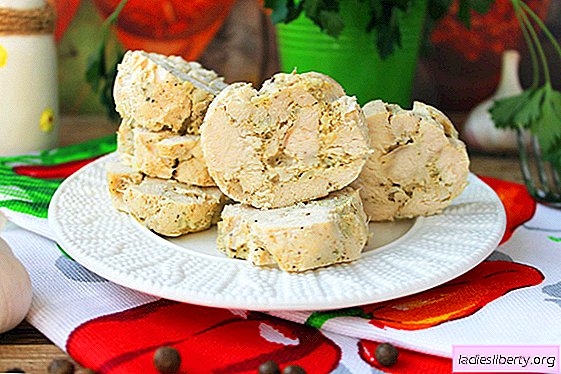
Hypertension is one of the most common diseases of the cardiovascular system of modern man.
This disease manifests itself in high blood pressure.
This disease cannot be completely cured, but it is possible and necessary to keep blood pressure under control at normal values. A large role is given to modern medicine diet for hypertension.
General principles of diet for hypertension
Clinical nutrition is of great importance in the treatment of hypertension. Compliance with the basic principles of dietetic nutrition reduces the risk of developing complications for hypertension such as diabetes mellitus, atherosclerosis, obesity, coronary heart disease, myocardial infarction, etc. General principles are characteristic of a diet for hypertension, according to which, patients should adhere to the following rules:
• Reduce existing overweight. This factor is of particular importance, since 80% of hypertensive patients who are overweight, its reduction reduces blood pressure;
• Limit or completely eliminate salt intake. This has a positive effect on the central nervous system (disorders in the work of which are one of the factors for the development of hypertension). Reducing the amount of salt in food normalizes kidney function. In addition, salt retains fluid in the tissues of the body, which is fraught with edema. By reducing the amount of salt to a minimum, a decrease in blood pressure is achieved by reducing the fluid in the blood. In 40% of hypertensive patients who use a salt-free diet, a decrease in blood pressure to normal levels occurs without the use of drugs;
• Enrich the diet with hypertension is necessary potassium, magnesium and calcium. Magnesium contained in foods dilates blood vessels and helps to reduce blood pressure. Magnesium also has a beneficial effect on the central nervous system, removing excitement. Its salts are found in nuts, sin, oatmeal, soy, carrots, dill, parsley, bananas, black currants and seafood.
• Potassium improves the condition of the heart muscle. Potassium salts are found in vegetables and fruits, which are useful to eat raw. A lot of potassium in potatoes, eggplant, cabbage, prunes, dried apricots, raisins, dates, apricots. If the body has a high level of potassium salts, then the patient can sometimes afford to use table salt in a small amount;
• Replace animal fats with vegetable fats in the diet. The fatty acids they contain help lower blood pressure. Seafood and oily marine fish also contain fatty acids that have a similar effect. This contributes to the normalization of lipid metabolism and reduces the level of bad cholesterol. In addition, seafood contains healthy protein, vitamins, mineral salts and iodine. Therefore, seafood and sea fish should be present in the diet for hypertension, which can replace animal meat;
• Limit sugar intake and foods with sugar content. When hypertension is often a violation of carbohydrate metabolism, which contributes to obesity and the development of atherosclerosis. Sugar can be replaced with fruits and vegetables rich in carbohydrates;
• Ensure optimal protein content in the diet. Apart from animal meat, their source is dairy products, fish and eggs;
• Ensure the intake of a sufficient amount of vitamins: C, A, E, group B, R. The source of vitamins - vegetables and fruits, which are depleted in sodium salts, have a low calorie content. Fiber contained in them stimulates the digestive tract, which contributes to the active elimination of cholesterol;
• Follow 5-6 meals a day. Small portions do not allow to overeat, overload the work of the gastrointestinal tract and heart;
• Reduce water intake to 1-1.2 liters per day (exclude carbonated drinks, salted mineral water, strong tea, coffee). Reducing the amount of free fluid in the body will facilitate the work of the heart muscle;
• Do not use strong alcoholic beverages, which destroy the walls of blood vessels. Red wine is acceptable in small quantities.
Methods of cooking for a hypertensive diet
Methods of food processing and cooking are no less important than the observance of the diet and the qualitative composition of the diet.
Such methods of processing products as roasting, smoking, salting, pickling for a diet with hypertension are unacceptable.
Products can be cooked, baked, braised, steamed.
For example, baked potatoes are very useful for hypertensive patients, which are consumed with the peel, but french fries are extremely useless.
Also, preference should be given to steamed cutlets than fried.
Instead of pickles and spicy seasonings you should use neutral seasonings, herbs, herbs, lemon juice.
Fans of sweets need to reorganize in the choice of sweet dishes, preferring fruits and dishes prepared on their basis.
There are many good recipes for cooking desserts with apples, dried apricots, prunes, bananas.
What can be included in the diet for hypertension
Nutritionists have chosen the main products that can be used by patients with hypertension. Based on them, you can make an individual menu for a week. In each case, the menu should be agreed with your doctor.
• Bakery and flour products: wheat, rye and grain bread, biscuits and biscuits, fresh pastries, with cottage cheese, meat, fruits and vegetables;
• Soups: vegetable and cereal on lean meat broths, green cabbage soup, borscht and beetroot soup, mashed soups, dairy, fruit;
• Meat: low-fat - boiled or baked; steamed meat dishes;
• Dairy products: milk and dairy products of low fat content, low-fat cottage cheese and cheese (salted);
• Fish: low-fat varieties of sea and river fish in baked and boiled form, seafood;
• Eggs: boiled, only proteins (2-3 eggs per week), scrambled eggs;
• Cereals: buckwheat, oatmeal, millet, barley;
• Vegetables: cabbage of different varieties, carrots, beets, potatoes, eggplant, cucumbers, pumpkin, tomatoes, green vegetables, garlic, onions;
• Fruits and berries: different types of raw fruits and berries, dried fruits;
• Drinks: tea with lemon, tea with milk, vegetable, fruit and berry juices, compotes (sugar free), infusions and decoctions;
• Fats: vegetable oil for cooking and for dressing salads (butter in very limited quantities, or completely excluded).
What to exclude from a diet for hypertension
In drawing up an individual diet for hypertension, dietitians recommend discarding the following foods:
• Butter bakery products, biscuits, fatty cakes and pastries, puffs. Also exclude flour products prepared by roasting (donuts, brushwood);
• Broths cooked on meat, fish, mushrooms, offal;
• Meat of fatty varieties, offal, sausages, smoked meats, canned food;
• Oily sea and river fish, all types of smoked, salted, pickled fish, salmon caviar;
• Dairy products with a high percentage of fat, cream, sour cream, cottage cheese, cheese curds;
• Cereals: semolina, rice;
• Pasta;
• Radish, radish, turnip, spinach, sorrel;
• All types of mushrooms;
• Sugar and its products, grapes, raisins, preserves, jams, ice cream, chocolate;
• Drinks: cocoa, coffee, hot chocolate, strong tea;
• Cooking fats, animals.
Approximate one-day menu: diet for hypertension
Based on the list of recommended products, you can create a day menu, which may look like this:
• First breakfast: scrambled eggs with vegetables, rye bread, tea with milk;
• Second breakfast: apple (fresh, or baked);
• Lunch: vegetable soup, steam meat patties, with buckwheat, lingonberry juice;
• Snack: vegetable salad;
• Dinner: salad with squid, with rice and vegetables, dried apricots compote;
• Second dinner: fat-free kefir.
Sample weekly menu for hypertonic
The first day
• Breakfast: oatmeal with dried apricots, tea;
• Second breakfast: banana, or apple;
• Lunch: vegetable soup puree, steamed cutlets, with buckwheat, fresh apple compote;
• Snack: fruit mousse;
• Dinner: fish baked with vegetables, compote of dried fruits, biscuits;
• At night: warm milk.
Second day
• Breakfast: cottage cheese with prunes, tea with milk;
• Second breakfast: grapefruit;
• Lunch: fish soup with cod, vegetable stew, tea with lemon. Rye bread;
• Snack: yogurt;
• Dinner: chicken fillet, baked in foil, with vegetable salad, lingonberry mors;
• Overnight: acidophilus.
Third day
• Breakfast: fruit salad, dressed with yoghurt, tea with milk, biscuits;
• Second breakfast: cottage cheese souffle;
• Lunch: vegetarian soup, boiled turkey, berry jelly;
• Snack: dates;
• Dinner: baked potatoes with cheese and vegetables, black bread, tea with lemon;
• For the night: baked milk.
Day four
• Breakfast: barley porridge with fruit, milk, black bread;
• Second breakfast: tomato juice;
• Lunch: mashed potato soup, steamed meatballs, with stewed vegetables, dried fruit compote;
• Snack: nuts (hazelnuts - 50 grams);
• Dinner: pilaf of chicken fillet, cucumber salad, berry fruit juice;
• For the night: kefir.
Fifth day
• Breakfast: barley porridge with berry syrup, milk, biscuits;
• Second breakfast: vegetable vinaigrette;
• Lunch: milk soup, noodles, steamed meatballs with a vegetable side dish, tea with lemon;
• Snack: walnuts (50 grams);
• Dinner: lazy cabbage rolls, black bread, jelly with galetny cookies;
• At night: the milk is warm.
Sixth day
• Omelet from 2 eggs, tea with lemon, brown bread;
• Second dinner: granola with kefir;
• Lunch: vegetable soup with meatballs, potatoes, baked with cheese and vegetables, fruit drinks, black bread;
• Snack: cottage cheese with dried apricots, apple juice;
• Dinner: vegetable stew with turkey, fruit jelly, biscuits, black bread;
• For the night: kefir.
Seventh day
• Vegetable salad, black bread and unsalted cheese sandwich, tea with lemon;
• Lunch: carrot juice;
• Lunch: soup from fresh cabbage, boiled meat with steamed vegetables, jelly with biscuits;
• Snack: fruit salad with yogurt;
• Dinner: fish, baked with vegetables, mors, black bread;
• For the night: tea with milk.
Nutritionists recommend not eating right before bedtime. The period of time before going to bed and the last meal should not be less than 2 hours.
What gives a diet for hypertension
Diet therapy for hypertension gives excellent results. Observing the simple rules of diet, a patient with hypertension (especially in the first stage of the disease) can reduce the risk of complications and minimize the number of medications taken.
A diet for hypertension does not cause difficulties in switching to it. The entire power system that has developed over the years should not be changed dramatically.
You can start by limiting salt, then sugar, then gradually reduce the amount of fat and meat. Thus, sharp jumps in blood pressure can be avoided. The result of the proper use of dietary nutrition is a stable decrease in blood pressure and its normalization.











